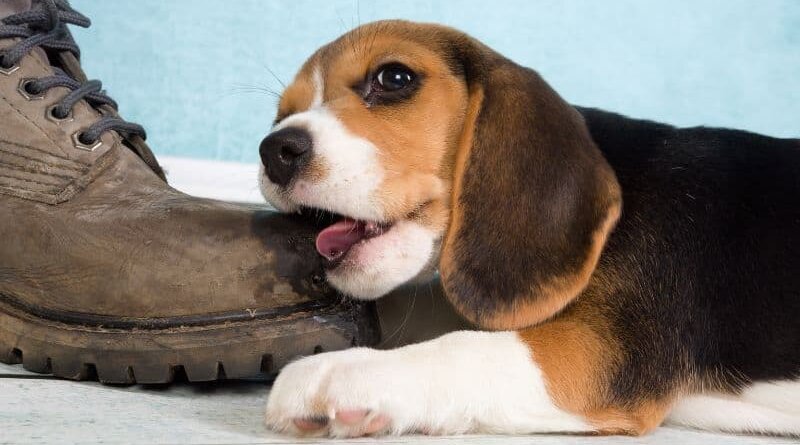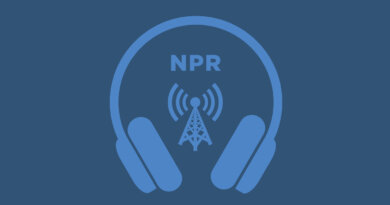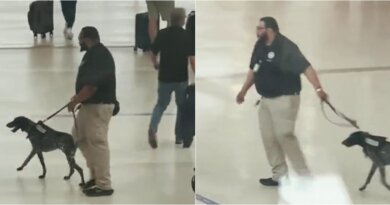How To Stop A Dog From Chewing On Things
This post may contain affiliate links. We may earn money or products from the companies mentioned in this post.
Is your dog always chewing on things?
After raising two puppies and caring for hundreds of client dogs, I’m happy to report that I’ve learned a thing or two about how to stop a dog from chewing on things!
Because here’s the thing – it doesn’t matter how old a dog is, they have an innate urge to chew, chew, chew.
Which can be super frustrating, especially when a puppy chews on furniture, shoes and your kids’ homework, right?
OK, so maybe your kids won’t mind the “ruff” draft, but you know what I mean.
Besides destroying your things, inappropriate dog chewing can also be dangerous for your pup’s health AND expensive if it warrants a trip to the (emergency) vet.
So in this blog post, I’ll talk about effective tactics to prevent and stop a dog from chewing on things.
Once you understand the underlying reasons behind a dog’s desire to chew, you can implement positive training techniques and offer appropriate dog chews to nip the behavior in the bud.
Sounds good? Here we go!
Why Do Dogs Chew On Things?
Before I dive into the solutions, it’s important to understand why dogs love chewing so much.
First and foremost, chewing is a normal dog behavior they’re born with and that they share with their wild relative, the wolf.
Keeping that in mind, dogs and wolves chew on bones to consume essential nutrients like calcium and phosphorus, exercise their jaws, massage their gums and relax!
Yep, that’s right, chewing naturally calms dogs down and also has the benefit of cleaning their teeth.
So when a puppy is teething, bored, anxious or stressed, they like to resort to chewing.
Lack of exercise or simply exploring their environment are other reasons why you may see your dog chewing on things.
Now that you understand the underlying cause, you can address it more effectively using four tactics:
- Keeping inappropriate items out of reach
- Offering appropriate alternatives to sink their teeth into
- Teaching them to choose those over your belongings
- Supervising or crating until your dog knows what not to chew on
Doggie Proofing Your Home
Similar to baby-proofing, it’s essential to create a safe environment for your dog, whether they’re adult pups or puppies.
That means keeping valuable or potentially dangerous items out of reach.
Store shoes, clothing, cables, and other tempting objects in closed closets or drawers.
You can also block off areas you don’t want your dog to have access to with baby gates for dogs or closed doors where possible. For example, the kitchen, your office or kids’ rooms.
Another option are dog crates, and I’ll provide some detail on them in a later section.
When I was preparing for the arrival of my puppies Missy and Buzz, I got down on all fours and visually inspected the floors of every room the pups were going to have access to.
That included the living room, dining area, kitchen, my bedroom and bathroom since I planned on giving the puppies baths in there, which I did.
And guess what, I found a few charging cables, a TV remote and some hair ties. I also had a stack of books sitting on the floor next to my work desk that I put up on shelves.
Also, I removed a bunch of magazines from the lower built-in storage area of my coffee table. Once the puppies had learned not to chew on inappropriate things, I put the magazines back down there.
But I had read somewhere that it’s better not to set puppies (and rescue dogs) up for failure by leaving stuff around, and this tactic worked out very nicely.
By the way, besides securing loose items and setting your pups up for success, this exercise is also a good opportunity to organize your things and get rid of stuff you no longer need or want.
You know, Marie Kondo style!
One last note on this section: Remind your kids to pick up their things and to leave the door to their room closed, at least until your puppy has learned to stop chewing on things that aren’t theirs.
What Are Good Things For Dogs To Chew On?
Now, as far as good, and most importantly, safe things for dogs to chew on, you’ll have to go shopping for your pup!
I’ll admit that’s one of my favorite pastimes. Actually, I love it way more than shopping for myself, but that’s just a side note.
For starters, you’ll get two lists of things dogs can chew on.
Spoiler alert: You won’t find dog chews like rawhide toys or nylon bones on them. That’s because they’re made with lots of synthetics and aren’t digestible, so it’s safer to avoid them.
Also, I’d steer clear from any dog toys or dog chews that mention flavors.
Like bacon flavor or chicken flavor because that also translates into synthetics as flavor is never the real deal.
Edible and fully digestible dog chews:
My puppies Missy & Buzz chewing on whole deer antlers
Non-edible chew dog toys:
You probably noticed that I mentioned the brand KONG several times – for a good reason, too!
They make most of their dog toys with durable, NATURAL rubber that’s all made in the USA.
All of my dogs have had and continue to have KONG toys, and so did many of my client dogs.
Honestly, if I had to narrow it down to one brand I’d choose KONG.
Mastiff clients Caymus and Wrigley with their kibble & pb filled KONGs
My pup Wally with a KONG tire I stuffed with green tripe sticks
Client pup Stanley with his KONG Jumbler chew toy
Tips To Keep Dog Toys Interesting & Safe
I recommend you avoid dog toys that resemble items you don’t want your dogs chewing on, as this can confuse them.
For example, TV remote- or shoe-shaped dog toys!
Additionally, rotate the dog toys regularly to keep them interesting and engaging.
Dogs who have bins full of toys and chew items are likely to focus their attention elsewhere because they get toy fatigue.
That’s something I’ve been able to observe over the years in many of my client homes!
So what you can do is set your pup up with one edible dog chew and one non-edible chew toy at a time, then rotate them every couple days or so.
Client pups with a pile of dog toys & chews
How To Train A Dog To Stop Chewing On Things
Now that you’ve picked up any loose items off the floor and bought your dog appropriate dog chews, you may wonder how to keep your pup from eating your furniture!
After all, you can’t pick that up too, right?
No, of course not, so you’ll have to teach your dog that chewing on things is only OK when it’s theirs.
Enter positive reinforcement training!
That’s a powerful tool for modifying your dog’s chewing behavior and encourages the right kind of chewing.
Here’s how it works:
- Make sure to catch them in the act, correct the behavior with a calm but firm NO, then redirect their attention to a suitable dog chew toy. You may need to physically redirect them using a leash.
- Reward them with verbal praise like “Good girl”!, and affection when your dog chews on appropriate toys.
PRO TIP: Smearing some peanut butter or plain yogurt onto the dog chew should help get them interested in it if they don’t seem convinced that their chew is better than the table.
Also, know that consistency and patience are key to stop a dog from chewing on things, and that some dogs learn faster than others.
Supervising And Crate Training Your Dog
Since it’s going to take a while to stop your dog from chewing on things, you’ll have to supervise them in the meantime.
But obviously, it’s unrealistic to keep a constant eye on your dog.
That’s why I recommend you consider crate training your pup for those times when you can’t actively watch them.
Click here to learn which dog crate is best for your puppy.
Client Beagles in their crates
This approach worked beautifully for my Boxer mix puppies and they ended up “graduating” from unsupervised crate time when they were about 2 years old.
At that point in time, they still had full access to their crates, but I no longer shut the crate door when I wasn’t home or not in the same room as they were.
That said, I personally didn’t feel comfortable leaving them home alone in their crate with most chew toys with the exception of stuffed and frozen Kongs.
That’s why the next section is essential for successfully crate training your dog!
Exercising Your Dog
Here’s the thing – a tired dog is less likely to engage in destructive behavior like chewing.
So all you have to do is ensure your dog gets plenty of physical exercise paired with some mental exercise prior to leaving them home alone in their crates.
You can accomplish this with a walk, a run and/or playtime like fetch, sprinkled in with some obedience elements to cover the mental exercise.
For example, you can ask your pup to “sit” or “stay” while out on walks, and practice playing fetch with specific rules. Like asking your pup to stay put while you throw the ball.
Tip: One of my favorite ways to increase physical exercise during a walk or run is by adding a doggie backpack.
Out on a backpack walk with client Bailey
However, for growing puppies you should wait until they’re about 8 to 9 months old before you add it to their exercise routine.
If you’re raising a giant puppy, consult your vet before you add a backpack to avoid putting too much strain on their joints.
But either way, if you exercise them properly, they’ll be much more likely to just walk into their crate and snooze in there until you’re back home.
Thankfully, dogs do sleep a lot, even as adults!
Seeking The Help Of A Professional Dog Trainer
If your dog’s chewing behavior persists or worsens despite your efforts, you may want to seek professional help from a dog trainer or animal behaviorist.
They can provide specialized guidance and develop a tailored plan to address your dog’s specific needs.
Just do a Google search for a qualified dog trainer near you, or ask friends with dogs, groomers, vets or pet stores for a recommendation.
Bottom Line
If you’ve made it this far, you should have a better idea of how to stop a dog from chewing on things!
While chewing is a natural behavior for dogs, it can become problematic, dangerous and expensive all at once when your puppy chews on the wrong objects.
Remember to use a positive training approach as you’re working on redirecting your dog’s chewing from your belongings to things dogs can chew on:
Catch your dog in the act, redirect, reward!
It’s best to be calm but firm in your approach as yelling at your dog won’t have the desired effect you’re looking for.
Until your dog has learned polite chewing manners, set them up for success by using crates, baby gates and lots of physical as well as mental exercise throughout the day.
Also, remember to rotate the dog specific chews you offer them rather than setting them up with a giant pile of dog chews.
At the end of the day, consistency, patience, and providing a stimulating environment are key factors in successfully stopping your dog from chewing on things they shouldn’t!
Save To Pinterest
Top Picks For Our Puppies
- BEST PUPPY TOY
We Like: Calmeroos Puppy Toy w/ Heartbeat and Heat Packs – Perfect for new puppies. Helps ease anxiety in their new home. - BEST DOG CHEW
We Like: Mighty Paw Naturals Bully Sticks – All of our puppies love to bite, nip, and chew. We love using Bully Sticks to help divert these unwanted behaviors. - BEST DOG TREATS
We Like: Crazy Dog Train-Me Treats – We use these as our high-value treats for our guide dog puppies. - BEST FRESH DOG FOOD
We Like: The Farmer’s Dog – A couple months ago we started feeding Raven fresh dog food and she loves it! Get 50% off your first order of The Farmer’s Dog.
Check out more of our favorites on our New Puppy Checklist.




